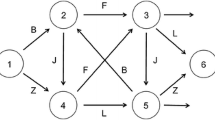Abstract
This paper proposes a learning-efficiency explanation of modular structure in language. An optimal grammar arises as the solution to the problem of learning a language from a minimal number of observations of instances of the use of the language. Agents face symmetry constraints that limit their ability to make a priori distinctions among symbols used in the language and among objects (interpreted as facts, events, speaker’s intentions) that are to be represented by messages in the language. It is shown that if it is commonly known that the object space is modular and messages are strings, then modularity of the language is sufficient and (essentially) necessary for learning efficiency. Journal of Economic Literature Classification Number: C72.
Similar content being viewed by others
References
A. Blume (2000) ArticleTitleCoordination and learning with a partial language Journal of Economic Theory 95 1–36
A. Blume U. Gneezy (2000) ArticleTitleAn experimental investigation of optimal learning in coordination games Journal of Economic Theory 90 161–172
V. Crawford H. Haller (1990) ArticleTitleLearning how to cooperate: Optimal play in repeated coordination games Econometrica 58 581–596
L. Hurwicz (1969) ArticleTitleOn the concept and possibility of informational decentralization American Economic Review 59 513–524
J.S. Jordan (1982) ArticleTitleThe competitive allocation process is informationally efficient uniquely Journal of Economic Theory 28 1–18
G. Kalai (2003) ArticleTitleLearnability and rationality of choice Journal of Economic Theory 113 104–117
K. Mount S. Reiter (1974) ArticleTitleThe informational size of message spaces Journal of Economic Theory 8 161–192
M.A. Novak D.C. Krakauer (1999) ArticleTitleThe evolution of language Proceedings of the National Academy of Sciences 96 8028–8033
Pinker S. (1999). Words and Rules New York: Basic Books.
A. Rubinstein (1996) ArticleTitleWhy are certain properties of binary relations relatively more common in natural language Econometrica 64 343–355
A. Vidyasagar (1997) A Theory of Learning and Generalizations. With Applications to Neural Networks and Control Systems Springer London
Author information
Authors and Affiliations
Corresponding author
Additional information
I am grateful to Hsueh-Ling Huynh, Bart Lipman, Ariel Rubinstein and Birger Wernerfelt for stimulating discussions and comments. Many thanks are due to the anonymous referee for suggestions that have helped to improve the focus and presentation of the paper. I have benefitted from comments by seminar participants at Arizona State University, Boston University, the University of California-San Diego, the University of Pittsburgh, the Wissenschaftszentrum Berlin für Sozialforschung (WZB), the Midwest Mathematical Economics Meetings, and the Summer in Tel Aviv (SITA). This research was supported by a Grant from the National Science Foundation.
Rights and permissions
About this article
Cite this article
Blume, A. A Learning-Efficiency Explanation of Structure in Language. Theor Decis 57, 265–285 (2004). https://doi.org/10.1007/s11238-005-0280-1
Received:
Revised:
Published:
Issue Date:
DOI: https://doi.org/10.1007/s11238-005-0280-1




